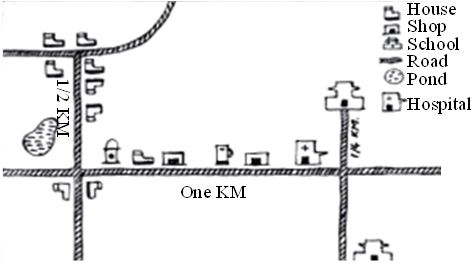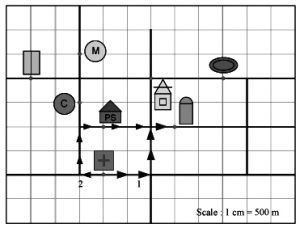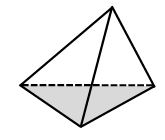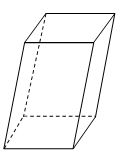10.1 INTRODUCTION
The circle, the square, the rectangle, the quadrilateral and the triangle are examples of plane figure; the cube, the cuboid, the sphere, the cylinder, the cone and the pyramid are the examples of Solid Shapes. Plane figures are of two dimensions (2–D) and the solid shapes are of three-dimensions (3–D). Three dimensional objects is that they all have some length, breadth and height or depth. That is, they all occupy space and have three dimensions. In this chapter, we learn about various three-dimensional objects.
Match the shape with the name

Sol : After matching the shape with their names are as follow
| (i) | (b) | (ii) | (d) |
| (iii) | (a) | (iv) | (c) |
| (v) | (g) | (vi) | (e) |
Match the 2 dimensional figures with the names

Sol : After matching figures with their names are as the follow :
| (i) | (b) | (ii) | (a) |
| (iii) | (e) | (iv) | (c) |
| (v) | (d) | ||
Perspectives (Views) of 3-D Shapes
Let us view a brick from front, side and top. How do they look like ?
They look like this :

For each of the given solid shapes, the three views are given :

10.2. MAPPING SPACE AROUND US
In Geography, you have been asked to locate a particular State, a particular river, a mountain etc., on a map. In History, you might have been asked to locate a particular place where some event had occured long back. You have traced routes of rivers, roads, railway lines, traders and many others. Look at the map of a house whose picture is given alongside.

What can we conclude from the above illustration? When we draw a picture, we attempt to represent reality as it is seen with all its details, whereas, a map depicts only the location of an object, in relation to other objects. Secondly, different persons can give descriptions of pictures completely different from one another, depending upon the position from which they are looking at the house. But, this is not true in the case of a map. The map of the house remains the same irrespective of the position of the observer. In other words, perspective is very important for drawing a picture but it is not relevant for a map.
Now, look at the adjacent map, which has been drawn by seven year old Raghav, as the route from his house to his school :

From this map, can you tell –
(i) how far is Raghav’s school from his house ?
(ii) would every circle in the map depict a round about ?
(iii) whose school is nearer to the house, Raghav’s or his sister’s ?
It is very difficult to answer the above questions on the basis of the given map. Can you tell why ?
The reason is that we do not know if the distances have been drawn properly or whether the circles drawn are roundabouts or represent something else. Now look at another map drawn by his sister, ten year old Meena, to show the route from her house to her school. This map is different from the earlier maps. Here, Meena has used different symbols for different landmarks. Secondly, longer line segments have been drawn for longer distances and shorter line segments have been drawn for shorter distances, i.e., she has drawn the map to a scale.

Now, you can answer the following questions :
1. How far is Raghav’s school from his residence ?a
2. Whose school is nearer to the house, Raghav’s or Meena’s ?
3. Which are the important landmarks on the route ?
Thus we realise that, use of certain symbols and mentioning of distances has helped us read the map easily. Observe that the distances shown on the map are proportional to the actual distances on the ground. This is done by considering a proper scale. While drawing (or reading) a map, one must know, to what scale it has to be drawn (or has been drawn), i.e., how much of actual distance is denoted by 1mm or 1cm in the map. This means, that if one draws a map, he/she has to decide that 1cm of space in that map shows a certain fixed distance of say 1 km or 10 km. This scale can vary from map to map but not within a map.
For instance, look at the map of India alongside the map of Delhi.
You will find that when the maps are drawn of same size, scales and the distances in the two maps will vary. That is 1 cm of space in the map of Delhi will represent smaller distances as compared to the distances in the map of India.
The larger the place and smaller the size of the map drawn, the greater is the distance represented by 1 cm.
Thus, we can summarise that :
1. A map depicts the location of a particular object/place in relation to other objects/places.
2. Symbols are used to depict the different objects/places.
3. There is no reference or perspective in map, i.e., objects that are closer to the observer are shown to be of the same size as those that are farther away. For example, look at the following illustration.

4. Maps use a scale which is fixed for a particular map. It reduces the real distances proportionately to distances on the paper.
Example 1. A map is given showing some landmarks of a city. The landmarks are replaced by symbols, whose meanings are given on right side of the map.
Answer the following questions.
(1) Ankit lives in the house H. How far is Ankit’s house from the school ?
(2) Which is nearby from Ankit’s house, stadium or hospital ?

Solution.
(1) School is at a distance of 2 + 1 = 3 km from Ankit’s house.
(2) Distance of stadium from Ankit’s house = 1 + 2 + 1 + 2 = 6 km
Distance of hospital from Ankit’s house = 1 + 2 + 1 + 1 = 5 km
Therefore, hospital is nearer than stadium from Ankit’s house.
Example 2.
The given figure shows the map of a compound of a boarding school. Answer the following questions. (i) Which of the following landmarks is nearest to the girls dormitory ?
A. Boys dormitory
B. Academic block
C. Auditorium
D. Powerhouse
(ii) Which landmark is situated at the northwest corner of the school compound ?

Solution.
(i) It can be clearly seen in the map that boys dormitory is nearer to girls dormitory as compared to academic block, auditorium, and power house.
(ii) The North West corner of the school compound in the given map is the dining hall.
Example 3.
The given figure shows the map of a locality which is drawn on a centimetre grid paper.
What is the shortest distance between the hospital and the post office ?

Solution. It can be seen in the map that there are two ways of reaching the post office from the hospital and the shortest is the one which is shown by blue arrows.

The scale used in the map is 1 cm = 500 m
Therefore, the shortest distance between hospital and post office
= 5 × 500 m = 2500 m
We know that 1000 m = 1 km
2500 m = km = km.
Thus, the shortest distance between the hospital and the post office is km.
10.3. FACES, EDGES AND VERTICES

The corners of a solid shape are called its vertices, the line segments of its skeleton are its edges; and its flat surface are its faces.
The 8 corners of the cube are its vertices. The 12 line segments that form the skeleton of the cube are its edges. The 6 flat square surfaces that are the skin of the cube are its faces.
Example 4. Complete the following table

Solution. Complete table is as follow :
| Faces (F) | 6 | 4 | 8 | 7 |
| Edges (E) | 12 | 6 | 20 | 15 |
| Vertices (V) | 8 | 4 | 9 | 10 |
Polyhedron Let us look at the following solid figures.

All of the above solid figures are made up of polygonal regions, lines and points. There is no curved surface in the given figures. Such solids are called polyhedrons.
The polygonal regions in polyhedrons are called the faces. The faces meet to form line segments which are known as edges. The edges meet at the points which are known as vertices.
| Hence, a polyhedron can be defined as a geometric object with flat faces and straight edges. |
Polyhedra are named according to the number of faces. For example: tetrahedron (4 faces), pentahedron (5 faces), hexahedron (6 faces) and so on. The first figure is the figure of a tetrahedron. The second figure is an octahedron. Now, what can we say about the solids like cylinders, cones, spheres etc.?
These solids have lateral surfaces as well as curved edges. It means that these solids are not formed strictly with only flat surfaces as well as straight edges. Therefore, we can say that the solids like cylinders, cones and spheres are not polyhedrons.
We can classify polyhedrons into different categories. Let us discuss them one by one.
A polyhedron may be a regular or an irregular polyhedron.
A polyhedron is said to be regular if it satisfies two conditions which are given as follows.
(a) Its faces are made up of regular polygons.
(b) The same number of faces meets at each vertex.
If the polyhedron does not satisfy any one or both of the above conditions, then we can say that the polyhedron is irregular. To understand this concept, let us consider two solids, i.e. a cube and a hexahedron, as shown below.

Here, we can see that the faces of the cube are congruent regular polygons (i.e. all the faces are squares of same dimension) and each vertex is formed by the same number of faces i.e. 3 faces. Therefore, a cube is a regular polyhedron.
For the hexahedron, the faces are triangular in shape and they are congruent to each other. It means that the faces of the hexahedron are congruent regular polygons. If we look at the vertex A, we will notice that 3 faces meet at A. On the other hand, at point B, 4 faces meet. Thus, the vertices are not formed by equal number of faces. Therefore, the hexahedron is an irregular polygon.
The polyhedron may be a concave or a convex polyhedron.
A polyhedron is said to be convex, if the line segment joining any two points of the polyhedron is contained in the interior and surface of the polyhedron. A polyhedron is said to be concave, if the line segment joining any two points of the polyhedron is not contained in the interior and surface of the polyhedron.
It can be understood easily by taking two solids, i.e. a cube and the star shaped polyhedron, as shown below.

For the cube, the line segment AB joining the two points A and B of the polyhedron is contained either in the polyhedron or on the surface which is clearly shown in the figure. Thus, a cube is a convex polyhedron. For the star shaped polyhedron, the line segment AB joining the two points A and B of the polyhedron is neither contained in the polyhedron nor on the surface.
Thus, the star shaped polyhedron is a concave polyhedron.
In this way, we can easily identify a polyhedron and classify it as concave or convex and regular or irregular.
Let us discuss one more example using the concept of polyhedron.
Example 5. How many faces are at least required to make a polyhedron ?
Solution. At least 4 triangular faces are required to make a polyhedron. For the base of the polyhedron, we require at least a three sided closed figure or a triangle (at least three sides are required to form a closed figure). Let us take another point which is not on the previous triangle. If we join the line segments from that point to each of the vertices of the base triangle, then we will have three triangles. In this way, we require 4 triangular faces to make a polyhedron as shown below.

Thus, at least four faces are required to make a polyhedron.
Prism and Pyramid
Two important members of polyhedron family around are prisms and pyramids.

We say that a prism is a polyhedron whose base and top are congruent polygons and whose other faces, i.e., lateral faces are parallelograms in shape.
On the other hand, a pyramid is a polyhedron whose base is a polygon (of any number of sides) and whose lateral faces are triangles with a common vertex. (If you join all the corners of a polygon to a point not in its plane, you get a model for pyramid).
A prism or a pyramid is named after its base. Thus a hexagonal prism has a hexagon as its base; and a triangular pyramid has a triangle as its base. What, then, is a rectangular prism? What is a square pyramid? Clearly their bases are rectangle and square respectively.
Example 6. Identify whether the polyhedron shown in the following figure is a prism or a pyramid and name it accordingly.

Solution. The polyhedron shown in the given figure has two identical hexagonal bases and the lateral surfaces are parallelogram in shape. Therefore, the given figure is a hexagonal prism.
Example 7. Is a rectangular prism a cuboid ?
Solution. In a rectangular prism, the top and base surfaces are rectangles. If the lateral surfaces of that rectangular prism are strictly rectangles, then we can say that the rectangular prism is a cuboid, otherwise not. However, the lateral surfaces may not be rectangles as shown below.
Therefore, a rectangular prism is not always a cuboid.

Euler s Formula
Every polyhedron has a specific number of faces, edges, and vertices (depending upon the type of polyhedron it is). However, is there any relation that can be applied to the number of faces, edges, and vertices of any polyhedron irrespective of the type of polyhedron?
Tabulate the number of faces, edges and vertices for the following polyhedrons:
(Here ‘V’ stands for number of vertices, ‘F’ stands for number of faces and ‘E’ stands for number of edges).
| Solid | F | V | E | F + V | E+2 |
| Cuboid | 6 | 8 | 12 | 14 | 12 + 2 |
| Triangular pyramid | 4 | 4 | 6 | 8 | 6 + 2 |
| Triangular prism | 5 | 6 | 9 | 11 | 9 + 2 |
| Pyramid with square base | 5 | 5 | 8 | 10 | 8 + 2 |
| Prism with square base | 5 | 6 | 9 | 11 | 9 + 2 |
What do you infer from the last two columns ? In each case, do you find F + V = E + 2,
i.e., F + V – E = 2 ? This relationship is called Euler’s formula.
In fact, this formula is true for any polyhedron.








